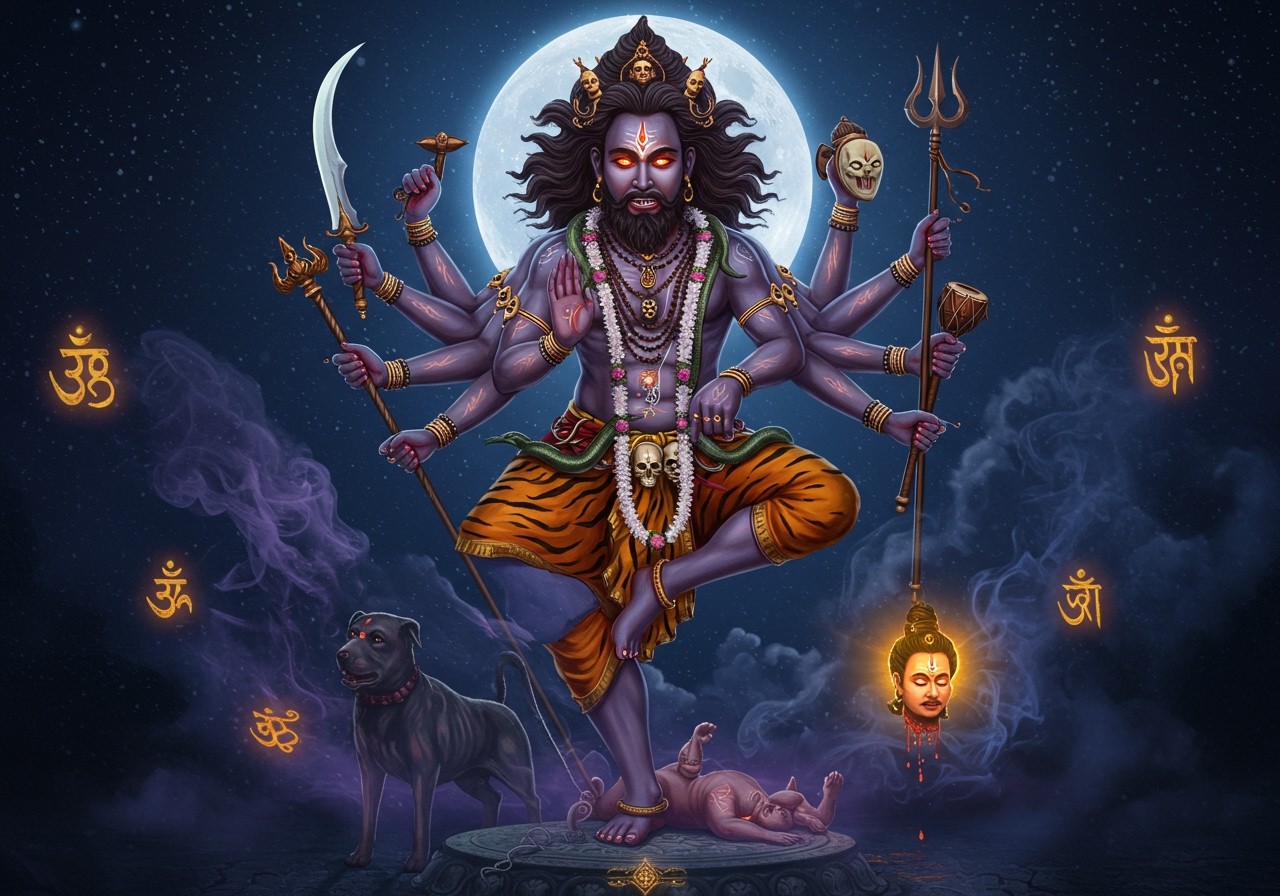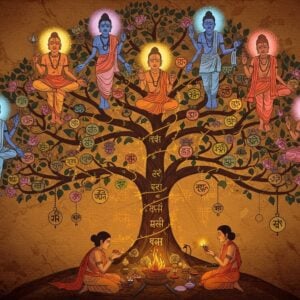
Bhairava, a potent and awe-inspiring manifestation of Lord Shiva, holds deep significance in Hindu mythology and spiritual practices. This article delves into the origins, importance, and diverse forms of Bhairava, offering insights for those seeking a deeper understanding of this revered deity. Exploring Bhairava’s essence not only enriches our spiritual knowledge but also enhances our appreciation of Hindu rituals and the divine pantheon.
Who is Bhairava?
Bhairava is a fierce form of Lord Shiva, renowned for his protective and powerful nature. Often depicted with a loyal canine companion, symbolizing unwavering protection and guardianship, Bhairava’s origins trace back to ancient scriptures. He is described as the guardian of the eight directions, safeguarding us from all sides. Worshipped primarily within the Shaivism tradition, Bhairava is revered for his ability to shield devotees from negative energies and influences. He is closely associated with time, known as Kala Bhairava, the lord of time, and is considered a deity who transcends the cycle of birth and death.
For those seeking a deeper connection with Lord Shiva, learn more about Mahabhairav deity, worship, and significance.
Meaning and Symbolism
The name “Bhairava” originates from the Sanskrit word meaning “frightful” or “terrible.” However, this powerful form of Lord Shiva isn’t meant to instill fear. Instead, He destroys fear itself, embodying courage and strength. His fierce yet protective image reminds us of the transient nature of life and the importance of spiritual discipline. Often depicted with multiple arms, Bhairava holds a trident and a drum, symbolizing his dominion over creation and destruction, representing the cyclical nature of existence.
The Significance of Bhairava Worship
Devotees believe that worshipping Bhairava bestows protection, prosperity, and spiritual advancement. Seeking his blessings is believed to remove obstacles and conquer fears, empowering individuals on their spiritual journey. Temples dedicated to him, such as the revered Kala Bhairava Temple in Ujjain, attract pilgrims from all corners of India and beyond. Rituals often include offerings of black sesame seeds and the lighting of oil lamps, signifying devotion and respect. Chanting specific mantras to honor Bhairava, particularly on Ashtami, the eighth day of the waning moon, is considered highly auspicious.
You can find authentic puja items and more at poojn.in, India’s leading online store for spiritual and cultural goods.
The Many Forms of Bhairava
Bhairava manifests in a multitude of forms, each possessing unique attributes and significance. The Ashta Bhairavas, the eight primary forms, are associated with the eight directions, representing his all-encompassing protection. Among these, Kala Bhairava, the lord of time, often depicted with a clock, holds a prominent place. Another form, Swarna Akarshana Bhairava, symbolizes wealth and attraction, reminding us of the abundance the universe offers. Each form is honored with specific rituals and offerings, tailored to the devotee’s spiritual aspirations.
Iconography and Representations
Bhairava’s imagery is rich in symbolism. Often adorned with a garland of skulls, he embodies mastery over death and the cycle of life. His faithful canine companion serves as his vahana (vehicle), symbolizing vigilance and loyalty. His third eye signifies omniscience and the power to vanquish evil, representing his divine insight. Fire, a symbol of purification and transformation, frequently appears in his depictions, highlighting his role in cleansing and renewal.
Cultural and Regional Variations
Bhairava’s worship varies across different regions of India, reflecting the richness and diversity of local traditions. In southern states, he often takes on the role of Kshetrapala, the guardian of villages and communities. In Nepal, he is revered as a powerful protector god, with the Akash Bhairav Temple in Kathmandu holding special significance. Each region celebrates unique festivals and rituals dedicated to Bhairava, weaving his presence into the cultural tapestry.
Learn more about the significance of temples and rituals with our insightful blog posts, like Shri Kala Bhairava Nath Swami Temple: A Sacred Journey and Mahabhairav Temple, Tezpur: History, Significance, Rituals & Legends.
How Poojn.in Helps You Connect with Lord Shiva
Poojn.in offers a wide selection of essential items for Lord Shiva worship, bringing the sacred into your home. As India’s largest Dashakarma Bhandar, we provide:
- Authentic Rudraksha Malas: Premium Rudraksha beads in various mukhi options to enhance your spiritual practice. We ensure the authenticity and quality of our Rudraksha beads, sourcing them from trusted suppliers.
- Pure Copper Items: Traditional copper vessels and ritual items crafted with high-grade copper for purity and durability. Copper is considered sacred in Hindu rituals and enhances the positive energy flow.
- Shiva Lingam: Sacred Shiva Lingams available in different sizes and materials for your home altar. We offer a variety of Shiva Lingams to suit individual preferences and needs.
- Puja Essentials: Complete puja sets containing all the necessary items for Shiva worship. Our puja sets make it convenient to perform rituals with all the required components.
- Dhoop and Incense: Special fragrances traditionally used in Shiva worship to create a sacred atmosphere. These fragrances enhance the spiritual experience and create a calming ambiance.
- Gangajal: Pure and certified Ganga water (Gangajal) essential for abhishekam and other rituals. We ensure the purity and sanctity of our Gangajal, sourcing it directly from the holy Ganges River.
Easily order these items through:
- Website: www.poojn.in
- Phone: 03369029784
- WhatsApp: 9476142738
All products are quality assured and carefully packaged. We deliver across India, ensuring the secure handling of sacred items. Our dedicated customer service team provides guidance on product selection and their usage in various Shiva-related rituals.
For bulk orders during festivals or special occasions, contact us in advance to ensure timely delivery. Become a member to enjoy special discounts and priority delivery. We value our customers and strive to provide the best service possible.
Conclusion
Understanding Bhairava deepens our appreciation for his multifaceted role in Hindu spirituality. His presence as a fierce protector, dispelling fear and negativity, offers solace and guidance to devotees. By exploring his origins, symbolism, and various forms, we connect more profoundly with the profound teachings he embodies. Whether seeking protection, prosperity, or spiritual growth, Bhairava’s worship provides a path to navigate life’s challenges with courage and grace. As traditions evolve, Bhairava remains a timeless guardian, connecting ancient wisdom with the present, inviting us to explore his mysteries with reverence and devotion.
Frequently Asked Questions About Bhairava
Who is Bhairava God? Bhairava is a fierce and powerful manifestation of Lord Shiva, known for his protective nature and often depicted as a guardian deity, safeguarding devotees from harm.
What does Bhairava mean? The name “Bhairava” translates to “terrifying” or “fearsome,” signifying Lord Shiva’s fierce aspect, symbolizing the destruction of evil and negativity.
Which god’s name is Bhairava? Bhairava is one of the many names of Lord Shiva, representing his fierce and protective form, a powerful manifestation of the divine.
Why is Bhairava important in Hinduism? Bhairava is important as he symbolizes the destruction of negativity and evil, revered for his ability to protect devotees from harm and bestow blessings.
What are the different forms of Bhairava? Bhairava has various forms, including the Ashta Bhairavas, each representing different aspects of life and the universe, offering a diverse range of divine energies.
How is Bhairava worshipped? Bhairava is worshipped through rituals that often involve offerings, prayers, and chanting of mantras, especially on auspicious days like Bhairava Ashtami.
What is the significance of Bhairava temples? Bhairava temples are significant as they are believed to be places of powerful energy, offering protection and removing obstacles from the lives of devotees who seek blessings.
Can Bhairava be worshipped at home? Yes, Bhairava can be worshipped at home with simple yet heartfelt rituals. This can include lighting a lamp, offering flowers, and reciting Bhairava mantras, creating a sacred space for connection.
Looking for a Tulsi Peeth for your home? Check out the beautiful options available at Poojn.in. We offer a variety of sizes and designs to fit any home altar.

